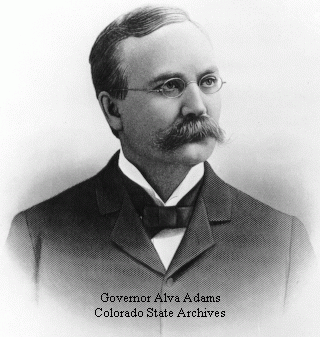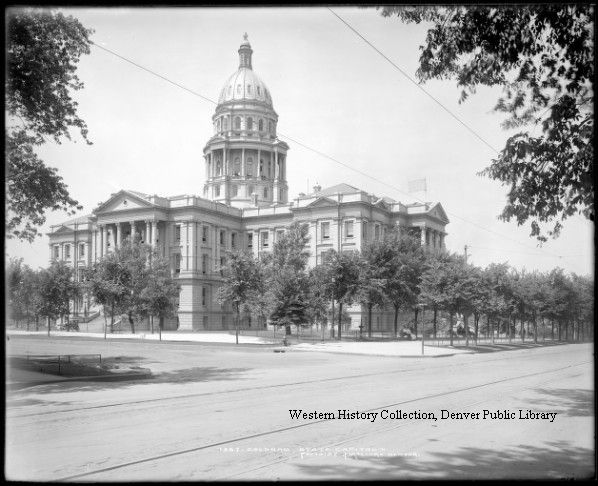The Day Colorado Had 3 Governors
In the summer and fall of 1903, Colorado entered what would become two of her most turbulent years in history. Union and non-union miners were engaged in violent showdowns with each other, and politicians with very different ideas of how to manage the escalating violence were up against each other in the polls.
 The mining towns around the state had entered into labor disputes over wages and union negotiations, and the mine owners, non-union miners, and union members were engaged in a war that was quickly getting out of hand. In September 1903, Governor James H. Peabody dispatched the Colorado National Guard to Cripple Creek at the behest of the mine owners in the area to deal with the escalating violence and all-out warfare in the mining camps (see James O. Chipman biography from the state archives web site). The violence and striking continued nearly unabated for the next year until June 6, 1904, when union employee Harry Orchard set off dynamite at a railroad station in Independence, Colorado, killing 13 non-union miners (see Chipman). This led to mass arrests of striking union members by the Colorado National Guard, led by General Sherman Bell. Many were rounded up and held in town in animal stockades, and some were taken out of town and dropped off at the Colorado-Kansas border (see Chipman).
The mining towns around the state had entered into labor disputes over wages and union negotiations, and the mine owners, non-union miners, and union members were engaged in a war that was quickly getting out of hand. In September 1903, Governor James H. Peabody dispatched the Colorado National Guard to Cripple Creek at the behest of the mine owners in the area to deal with the escalating violence and all-out warfare in the mining camps (see James O. Chipman biography from the state archives web site). The violence and striking continued nearly unabated for the next year until June 6, 1904, when union employee Harry Orchard set off dynamite at a railroad station in Independence, Colorado, killing 13 non-union miners (see Chipman). This led to mass arrests of striking union members by the Colorado National Guard, led by General Sherman Bell. Many were rounded up and held in town in animal stockades, and some were taken out of town and dropped off at the Colorado-Kansas border (see Chipman).
 In November of 1904, Governor Peabody was up for reelection as the governor of Colorado against former Governor Alva Adams, whose Democratic party was running under the slogan “Anybody but Peabody!” (see Chipman). Adams had previously dealt with violent conflicts between union and non-union miners and believed arbitration, not military intervention, was the best way to settle labor disputes (see Jason Brockman biography). On election day, the outcome appeared to go in Governor Adams’ favor.
In November of 1904, Governor Peabody was up for reelection as the governor of Colorado against former Governor Alva Adams, whose Democratic party was running under the slogan “Anybody but Peabody!” (see Chipman). Adams had previously dealt with violent conflicts between union and non-union miners and believed arbitration, not military intervention, was the best way to settle labor disputes (see Jason Brockman biography). On election day, the outcome appeared to go in Governor Adams’ favor.
However, the Republican-led legislature, along with (now former) Governor Peabody, believed otherwise. On January 6, 1905, a joint session of the Fifteenth Colorado General Assembly considered a written protest by Mr. Peabody that expressed his concerns about recent ballot-tampering in the gubernatorial election. He claimed that Governor Adams had committed voter fraud and rigged the election in multiple counties around the state, including Denver, Teller, Pueblo, Huerfano, and Las Animas – all of which included mining communities (see state archives site and Adams’ inaugural address). In Denver, one district reported 717 ballots cast for Governor Adams, despite the fact that only 100 legal voters lived within that district (see Brockman).
After considering Mr. Peabody’s protest, the legislature passed a resolution finding his claims to be of merit and set up a subcommittee to investigate the elections held within Denver and its surrounding areas (see Archives). The committee was charged with making daily progress reports to the joint General Assembly with the end goal of determining which candidate received the plurality of votes and should be elected Governor of the state of Colorado (see Archives). On March 16, 1905, after reviewing the election evidence, the committee declared voter fraud had been committed by both candidates and declared James H. Peabody the winner of the gubernatorial election on one condition:
That he resign the very next day.
Governor Peabody was sworn in as Colorado’s governor on March 16, 1905, replacing sitting Governor Alva Adams, who had been declared the initial winner after the election. Governor Peabody resigned the next day on March 17, 1905, and was replaced by his lieutenant governor, Jesse F. McDonald. Governor McDonald served as Colorado’s governor from 1905 to 1906. And that is how Colorado earned the dubious distinction of having gone through three governors within approximately 24 hours.
For more information on this event and the Governors involved, visit the State Archives site at http://www.colorado.gov/dpa/doit/archives/digital/election1904.htm and the governors’ pages at http://www.colorado.gov/dpa/doit/archives/govs/adams.html#biog and http://www.colorado.gov/dpa/doit/archives/govs/peabody.html#biog.

